Chaat is Indian Street Food that is a paradox in a plate. It’s hot and cold, soft and crunchy, sweet and tangy, spicy and soothing—all in one riotous bite.
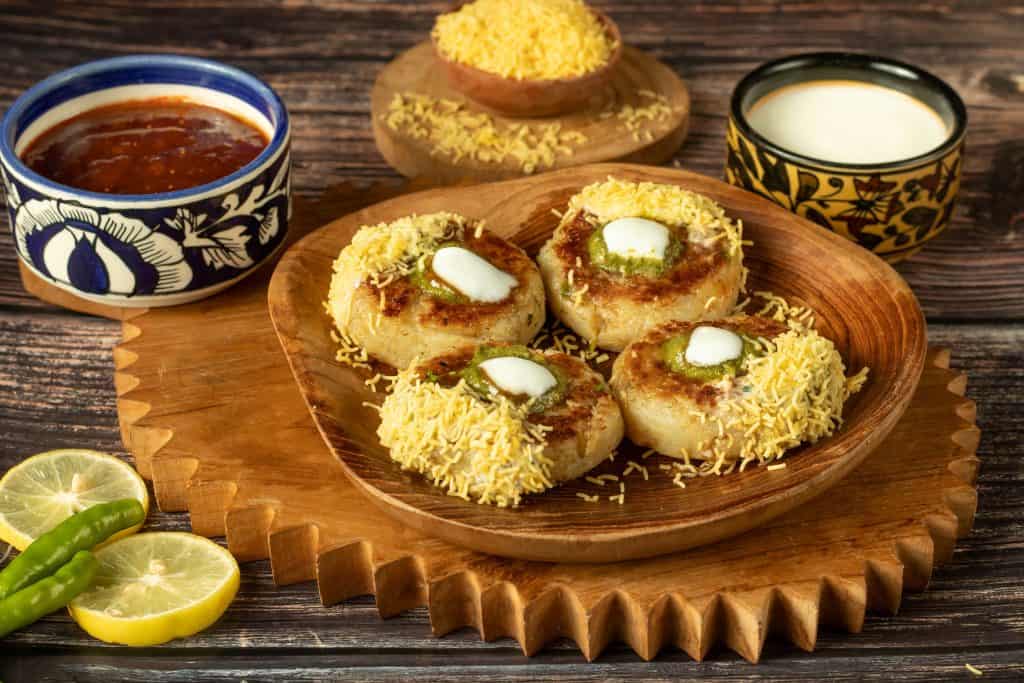
You don’t eat chaat. You devour it, lick your fingers clean, and go back for seconds, often without a second thought. Its flavours are bold, unapologetic, and impossible to forget.
In the humming heart of India’s cities, where honking autos and the rustle of saris form the soundtrack of daily life, one aroma calls out louder than most—the unmistakable aroma of chaat. It’s not fine dining. It doesn’t arrive under a silver dome. Yet few street food command such loyalty, spark such nostalgia, or inspire such passionate debate as chaat does. It is an emotion, a conversation starter, and quite often, an argument about who makes it best.
And the history of chaat? As colourful and layered as the dish itself.
From Royal Remedy to Roadside Rockstar
The roots of chaat according to legend go back to the 17th century. Delhi’s water was known to be heavy on alkalinity, which caused digestion troubles. Apparently doctors of that time are believed to have prescribed a diet rich in spices, yogurt, and tamarind to neutralise the effects.
In time home cooks and royal chefs took the medicinal advice and turned it into art—thus, chaat was born. What began as a therapeutic blend of ingredients to aid digestion transformed into an indulgence served on the streets, evolving with the tastes and preferences of every region.
Chaat derives its name from the Hindi verb “chaatna,” meaning “to lick.” It’s an apt name. The combination of salty, sour, spicy, and sweet makes it impossible not to lick your fingers once the plate is wiped clean.
The Chaat Blueprint
Every chaat plate is an architectural marvel of contrasts. The foundation is often something starchy—boiled potatoes, crisp papdi (small fried discs), or puffy puris. Over this base come layers of flavour: boiled chickpeas or sprouted lentils for protein, juicy diced onions and tomatoes for freshness, and lashings of cool, creamy yogurt. Then come the chutneys—green coriander-mint for herbaceous fire, tamarind-date for rich sweetness, and a touch of red chilli or garlic chutney if you’re feeling brave.
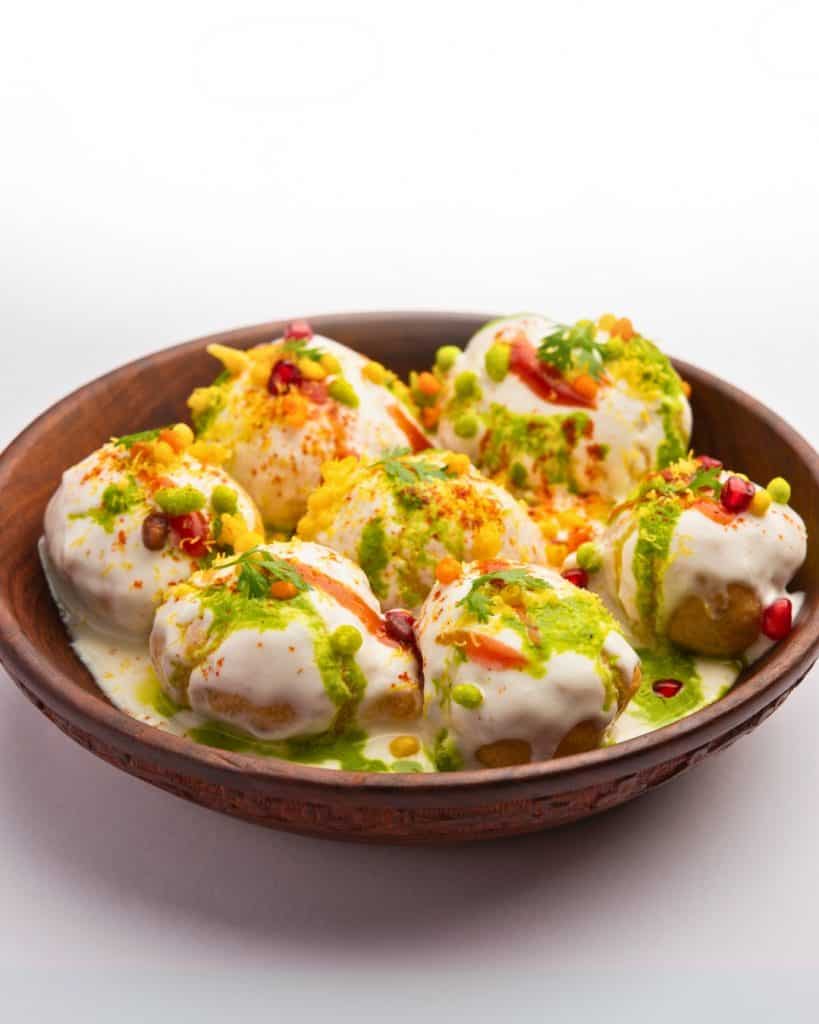
Spices are non-negotiable. Chaat masala, a sour-salty-sulphuric blend of black salt, amchur (dried mango powder), cumin, and other spices, is the heartbeat of every chaat. It wakes up the taste buds and brings all the disparate ingredients into harmony. Finally, the crunch—sev (thin fried chickpea noodles), crushed puri, or even fried potato juliennes—gives the dish its addictive texture. Garnishes like coriander leaves, pomegranate pearls, and a squeeze of lime juice complete the picture.
How Indian cities Do Chaat Differently
While the philosophy of chaat remains constant—balance, contrast, explosion—its interpretation varies wildly across the subcontinent. Each region has its signature dishes, ingredients, and even styles of preparation, influenced by local palate and produce.
In Delhi, chaat is a legacy. The capital’s iconic aloo tikki chaat features spicy, shallow-fried mashed potato patties drenched in yogurt and chutneys, then dusted with generous helpings of chaat masala. Dahi bhalla, another favourite, offers cool lentil dumplings soaked in thick curd, sprinkled with chilli powder and tangy tamarind sauce—a comfort food that’s both indulgent and refreshing.
Down in Mumbai, chaat leans towards the light and textural. Bhel puri is the king here—a mix of puffed rice, raw onions, tomatoes, green chillies, tamarind chutney, and sev. It’s a snack that crackles in your mouth. Its cousin, sev puri, replaces puffed rice with crisp puris individually topped with chutneys, potatoes, onions, and a generous layer of sev.
Kolkata’s chaat culture revolves around puchka, the Bengali version of pani puri, filled with spiced mashed potatoes and tamarind water so tangy it makes your eyes water and your heart sing. Jhal muri, another Bengali classic, is a dry variant of bhel with mustard oil, chillies, and a sharp attitude.
In Lucknow, the home of nawabs and food that whispers aristocracy, you’ll find the spectacular tokri chaat or basket chaat. Here, a crisp basket made of julienned fried potatoes becomes the edible container for a melange of potatoes, chickpeas, yogurt, chutneys, and pomegranate seeds—a decadent dish that’s somehow both street and royal.
Then there’s Varanasi, where tamatar chaat reigns supreme. Unlike other versions, this one is served hot and features mashed tomatoes sautéed with ghee, ginger, and garam masala, finished with the usual chaat garnishes. It is tart, spicy, and oddly satisfying, a perfect reflection of the holy city’s chaotic charm.
The Icons: Paapdi Chaat, Aloo Tikki, Raj Kachori, and Samosa Chaat
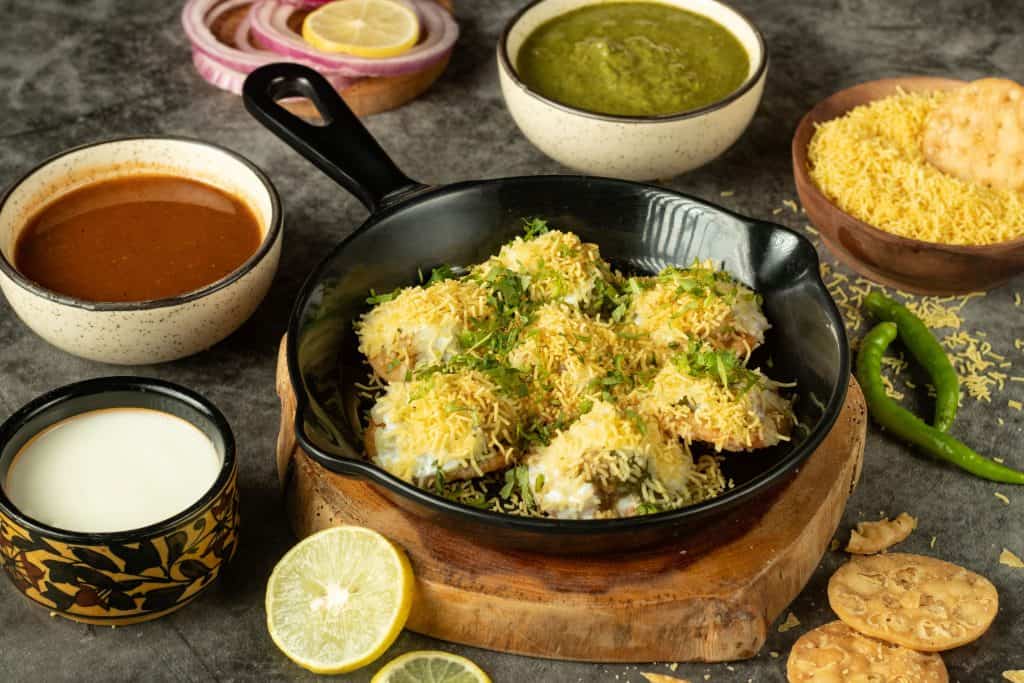
Every region of India has contributed something special to the ever-expanding universe of chaat, but a few dishes have transcended local fame to achieve national cult status. Among these legends are three powerhouses: Papdi Chaat, Aloo Tikki, Raj Kachori, and Samosa Chaat. Each is built on a humble base—potatoes, pastry, or lentils—but elevated by imagination, spice, and sheer street food genius. Let’s dive into their delicious world.
Papdi Chaat: The North Indian Street Star
If you had to choose one dish to represent the very soul of Indian street food, papdi chaat would be a strong contender. It’s everything a perfect chaat aspires to be—crispy, creamy, tangy, spicy, refreshing—and it does all this while looking like edible confetti. There’s an elegance in its arrangement and a chaotic brilliance in how it tastes. At first glance, papdi might appear simple, but bite into it, and it delivers a sensory rollercoaster that defines the very essence of chaat culture.
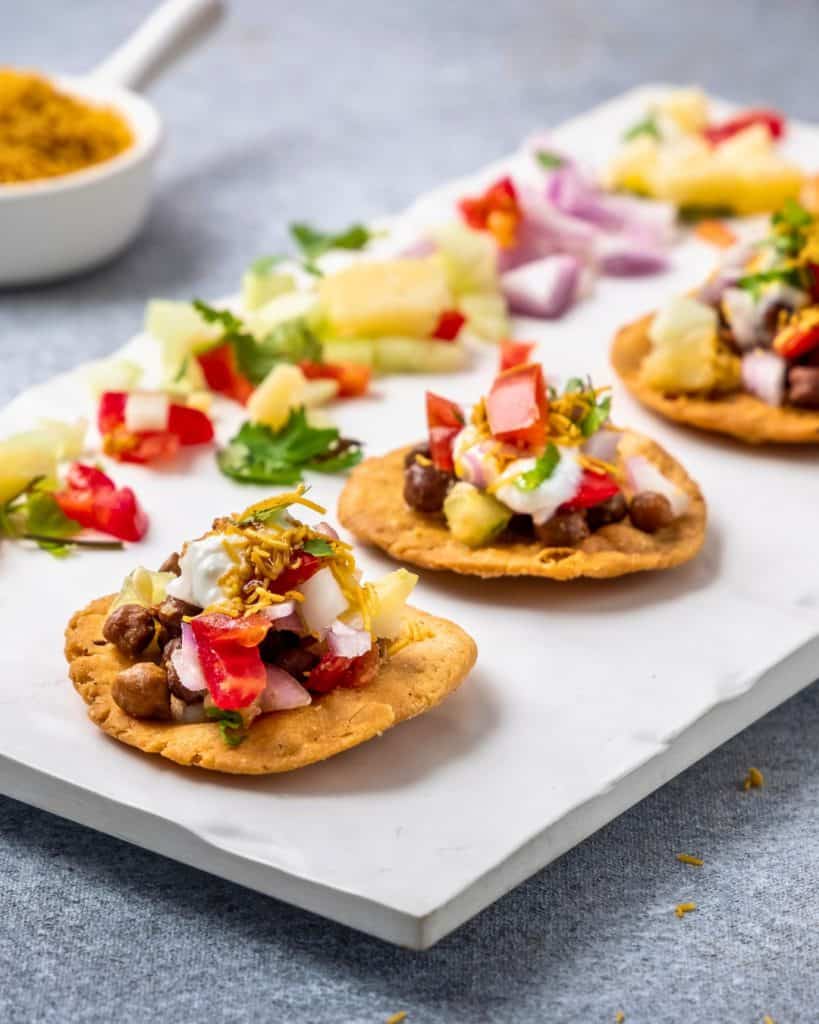
Papdi chaat takes its name from “papdi,” the crisp, fried flour discs that form the base of the dish. These discs—thin, golden, and delicately flaky—are the perfect vehicle for carrying a dollop of cool yogurt, a spoonful of boiled potatoes or chickpeas, and generous helpings of tangy chutneys. The toppings are applied with casual flourish: green mint-coriander chutney for freshness, tamarind-date chutney for sweetness, and spicy red chilli chutney for that unexpected punch. Chaat masala is sprinkled with dramatic flair, followed by a generous shower of sev and pomegranate seeds.
What sets papdi chaat apart is the way it balances so many elements without overpowering the palate. The crunch of the papdi contrasts with the creaminess of the yogurt, the softness of the potatoes, and the tang of the chutneys. It’s not a warm dish, which makes it particularly appealing in Delhi’s sweltering summers, and it requires no heavy curry—only layering, timing, and a good hand for proportion.
Papdi chaat has long been associated with the chaatwalas of Delhi. No visit to the capital is complete without a quick stop at Bengali Market, Lajpat Nagar, or Chandni Chowk, where vendors expertly construct the dish in seconds and hand it over with a nod that says, “Wait till you try this.” Though deeply rooted in Delhi’s food history, papdi chaat is equally beloved in cities across Uttar Pradesh—like Lucknow and Kanpur—where it’s served in small steel plates, with a bit more yogurt and a dusting of roasted cumin powder.
Interestingly, papdi chaat has found admirers far beyond the Hindi belt. In Mumbai, where bhel rules the streets, papdi chaat has quietly made space for itself in mithai shops and casual eateries. In Gujarat, vendors add their own spin by tossing in crushed peanuts or using thinner yogurt. In modern times, fusion chefs have played with it, serving it in tart shells, as bite-sized hors d’oeuvres at weddings, or even using beetroot or spinach-infused papdis to add colour.
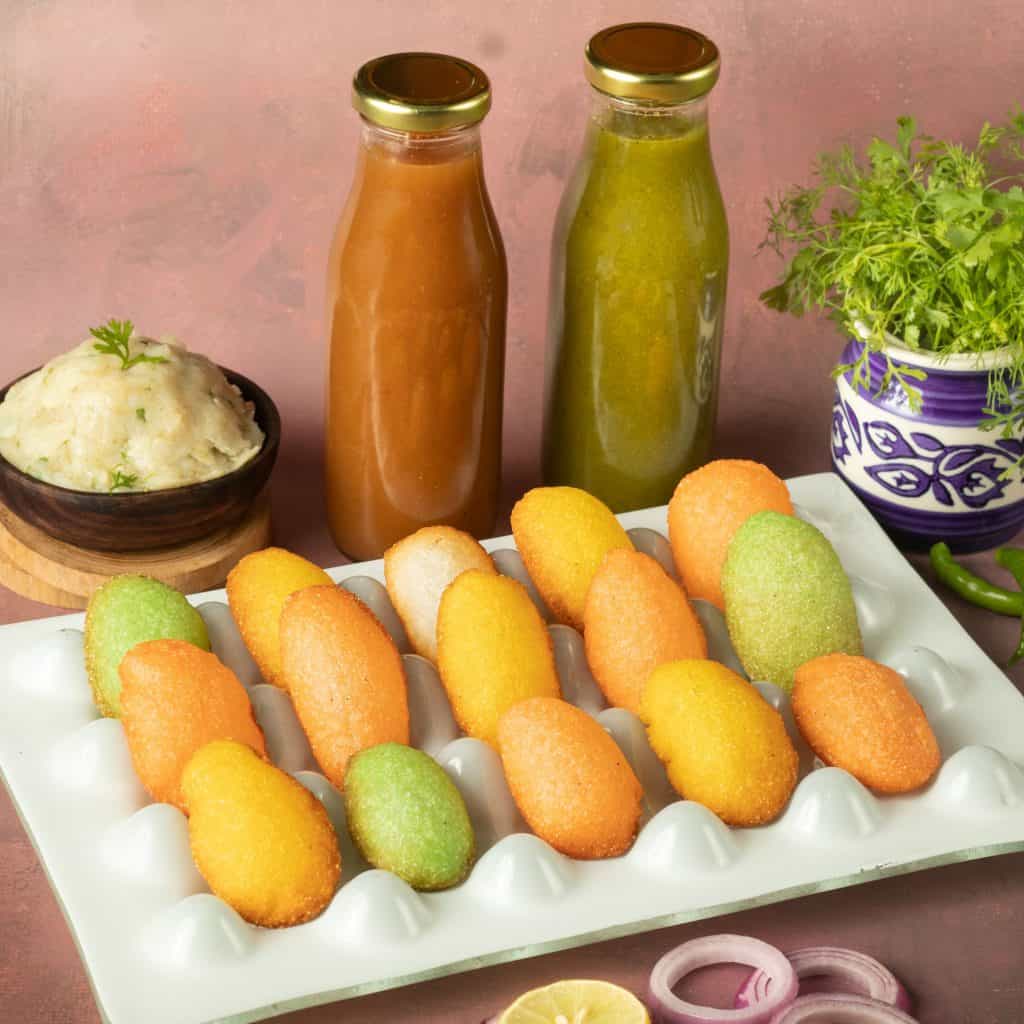
Despite these reinventions, the charm of traditional papdi chaat remains unshaken. It doesn’t need tweaking to impress. Its beauty lies in its familiarity—something that tastes like after-school childhood outings, like an impromptu stop during a shopping spree, or a quick hunger fix after work. It’s that one dish everyone agrees on, even when there’s a family debate over what to order.
Papdi chaat isn’t loud like Raj Kachori or heavy like Samosa Chaat. It’s subtle, measured, and yet wildly flavourful—a quiet contender that holds its own amid giants. With every bite, it reminds you why India’s street food is second to none.
Aloo Tikki: Delhi’s Golden Darling
Golden and crisp on the outside, soft and spiced within—Aloo Tikki is the quintessential North Indian comfort snack. A simple potato patty might sound ordinary, but in Delhi, it becomes extraordinary. The streets of Connaught Place and Kamla Nagar come alive every evening with the sizzle of patties being flattened on a hot griddle and browned to perfection.
Traditionally made with mashed potatoes mixed with spices like cumin, coriander, and red chilli, the tikki is sometimes stuffed with a tangy chana dal or green peas filling before being shallow fried. What makes it a true chaat, though, is what comes after. Once plated, it’s topped with a generous ladle of chilled yogurt, tangy tamarind chutney, fiery green chutney, crunchy sev, and a dash of chaat masala that brings it all together.
Though Delhi lays claim to its fame, Aloo Tikki is a star from Lucknow to Amritsar, where street vendors serve it with variations like a topping of spicy chickpea curry or a side of fried green chillies. In Uttar Pradesh, especially in cities like Kanpur and Agra, the tikki often comes with an extra helping of tamarind chutney so thick and syrupy it borders on dessert.
Raj Kachori and Ghevar Chaat : Rajasthan’s Regal Chaat
If chaat had a royal court, Raj Kachori would be seated on the throne. Aptly named—the word “Raj” means king—this oversized, hollow puri is the grandest of them all. Its structure is a delicate balloon, deep-fried to a perfect crunch, and then cracked open like a treasure chest to reveal its many riches.
Inside, the Raj Kachori holds an indulgent mix of spiced boiled potatoes, sprouted moong beans, boiled chickpeas, crushed papdi, and occasionally boondi (fried chickpea pearls). It is then flooded with smooth yogurt, both tamarind and mint chutneys, and topped with pomegranate seeds, coriander, and a liberal cloud of sev.
This showstopper chaat is deeply associated with Rajasthan and is a festive staple in cities like Jaipur, Jodhpur, and Udaipur. However, Delhiites have embraced it wholeheartedly—especially at outlets like Haldiram’s and Bikanervala—where queues often form around this single item. In Gujarat, a sweeter and slightly less spicy version is preferred, with an extra helping of meethi chutney and crushed peanuts for added flair.
Eating a Raj Kachori is not a dainty affair. It’s large, filling, messy, and meant to be demolished with abandon. It doesn’t pretend to be light or subtle—it is the drama queen of chaat, and proudly so.
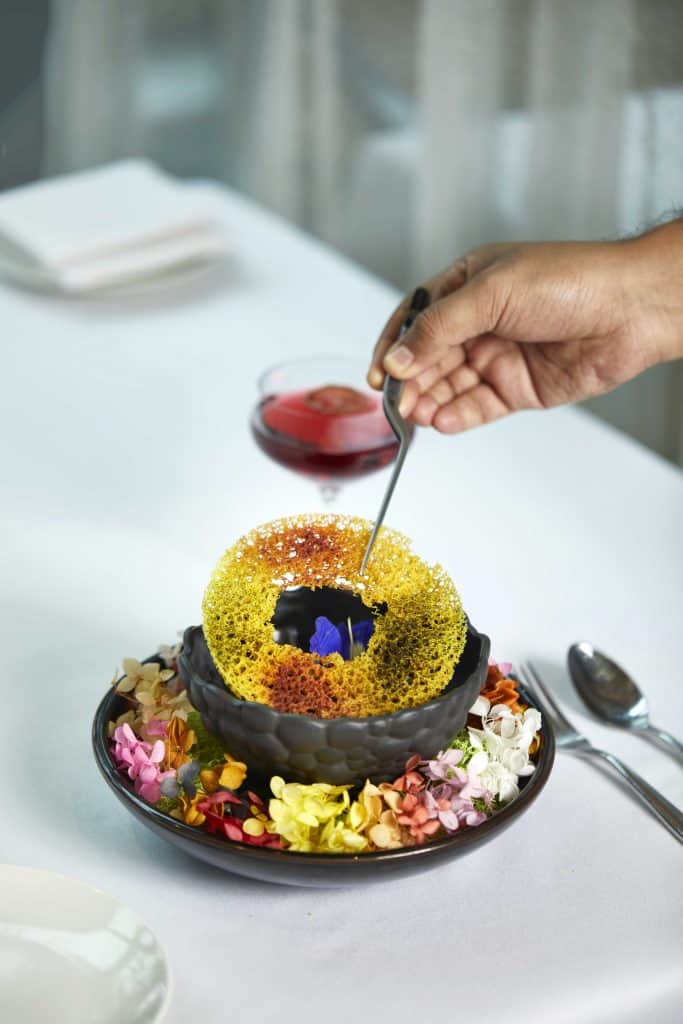
Samosa Chaat: The Fusion that Feels Like Home
If chaat is an Indian orchestra, then samosa chaat is that unexpected solo that still blends beautifully. It begins with the samosa, a triangular pastry packed with spicy potato filling, usually eaten on its own with a side of chutney and hot chai. But in the hands of a street vendor with flair, it becomes something far more exciting.
Samosa chaat is essentially a deconstructed samosa. The pastry is crushed while still warm, placed on a plate, and smothered in spicy chickpea curry or ragda (a white pea stew more common in Maharashtra). Over this, vendors layer yogurt, tamarind chutney, mint chutney, onions, and chaat masala. Sev and coriander leaves make the final flourish, transforming a familiar snack into a dish that feels both nostalgic and brand new.
The dish is a runaway hit in Punjab—particularly in Amritsar and Chandigarh—where the chickpea curry is spicy, rich, and sometimes cooked in ghee for extra depth. In Delhi, versions are more yogurt-forward with a balance of sweet and heat, while in Mumbai, it’s often made with ragda and paired with a thinner green chutney and diced tomatoes.
Samosa chaat also reflects India’s changing culinary landscape. It’s a dish made for the Instagram generation—bold, vibrant, full of textures, and offering familiar flavours in unfamiliar form. It’s both comfort food and a creative twist, the kind of thing you’d find on a college campus cart or a fine-dining fusion menu with equal ease.
Why These Classics Matter
Aloo Tikki, Raj Kachori, and Samosa Chaat are cultural snapshots. They reflect regional styles—Delhi’s tangy obsession, Rajasthan’s royal extravagance, Punjab’s hearty appetite, Mumbai’s coastal spice. They tell stories about tradition, creativity, and the ingenuity of India’s street food culture.
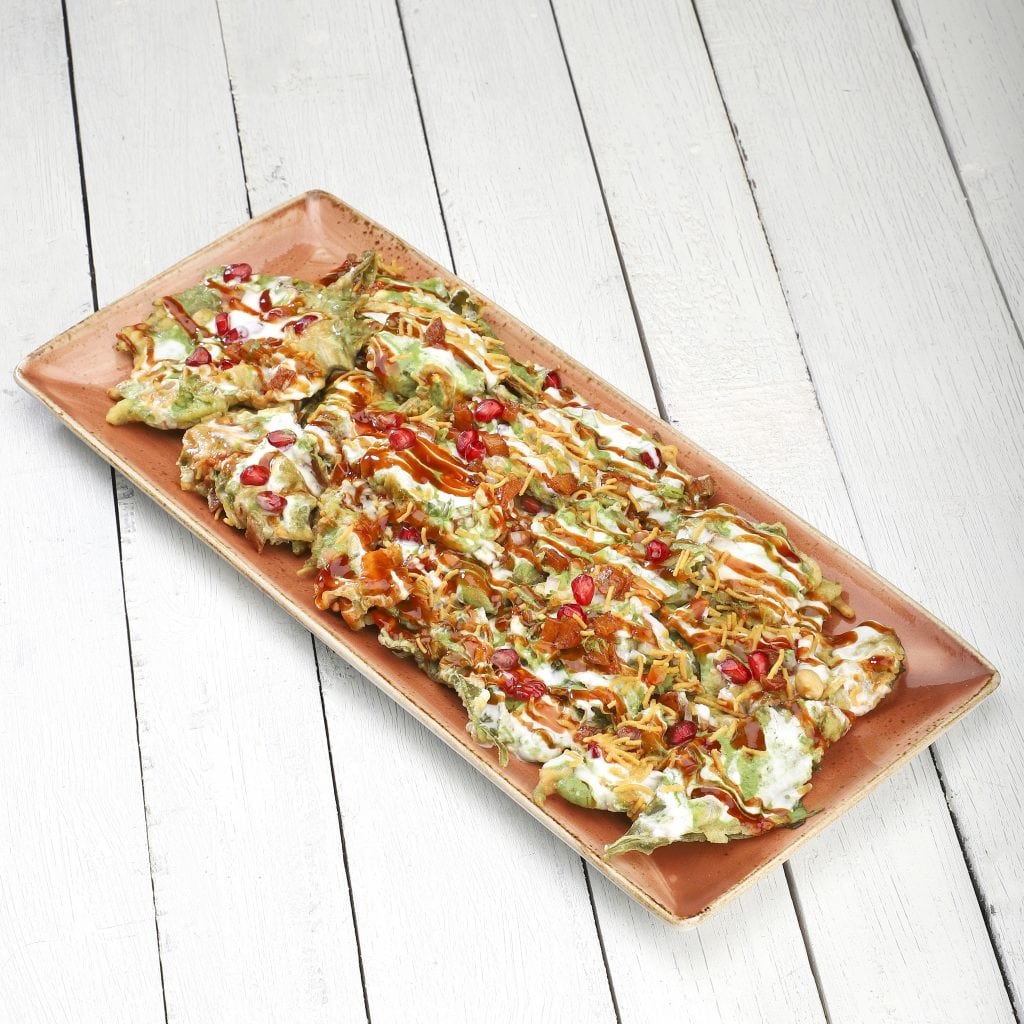
Each of these chaats is more than the sum of its ingredients. They are culinary performances, constructed on hot iron tawas and in deep kadhais, served in leaf bowls or stainless steel plates, and devoured with gusto. They feed the working class, the college student, the tourist, the local, and the gourmand. They show how something humble like a potato, a fried shell, or a pastry can be transformed into a snack that delights millions daily.
And that is the real charm of Indian chaat—it doesn’t demand attention, but it always steals the show.
Famous Chaat Destinations: Where Legends Are Made
Ask any Indian where the best chaat is, and you’ll get as many answers as there are people. Still, some names have earned near-mythical status. In Delhi, Ashok Chaat Corner in Old Delhi is practically a pilgrimage site. Known for their fruit chaat and spicy bhalla papdi, it’s an essential stop for food lovers.
Also in Delhi, Vaishno Chaat Bhandar in Kamla Nagar sees serpentine queues during the evenings for its perfectly spiced golgappas and spicy aloo chaat. In Mumbai, Elco Pani Puri Centre in Bandra has been dishing out hygienic, high-quality pani puri for decades, a rare feat in the street food world.
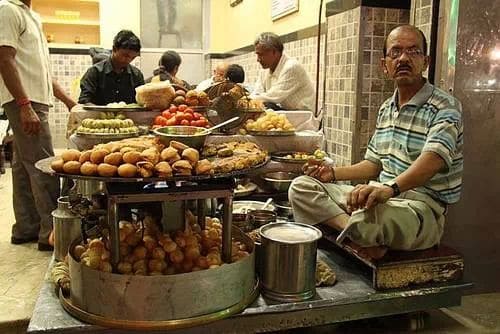
In Varanasi, Kashi Chaat Bhandar and Deena Chat Bhandar are famed for theirs lip-smacking specials like tamatar and palak (spinach) chaat, while in Kolkata, Maharaja Chaat Centre has earned acclaim for its eclectic variety of puchkas and ghugni chaat (spiced yellow peas with chutneys).
How to Make Chaat at Home
Want to bring the street magic into your kitchen? Here’s a classic chaat recipe that’s as adaptable as your spice tolerance.
Ingredients
- 2 boiled potatoes, peeled and diced
- 1 cup boiled chickpeas (or sprouted moong)
- ½ cup finely chopped onion
- ½ cup chopped tomatoes
- ½ cup whisked yogurt
- 2 tbsp tamarind-date chutney
- 2 tbsp green chutney (mint-coriander)
- 1 tsp chaat masala
- Salt to taste
- A handful of sev or crushed papdi
- Chopped coriander leaves and pomegranate seeds for garnish
Method
- In a large mixing bowl, combine potatoes, chickpeas, onions, and tomatoes.
- Add salt and chaat masala, mixing gently to coat the ingredients evenly.
- Spoon in the chutneys and mix again, adjusting spice and tanginess to your liking.
- Add yogurt and toss gently to combine without making it too runny.
- Transfer to serving plates, top with sev or papdi, and finish with coriander and pomegranate.
The Soul of Chaat: An alechemy of Spices
What gives chaat its unmistakable punch—the reason one bite leaves you breathless and craving another—is its meticulous, magical blend of spices. Chaat isn’t about heat alone. It’s about building layers of flavour so complex, so expressive, that your palate feels like it’s waltzing through a spice market.
At the heart of this flavour explosion is chaat masala, a curated blend of spices that come together to create a bold, tangy, salty, and slightly sulphuric profile. Ground cumin leads the charge with its earthy warmth, toasted to coax out its smoky undertones before being crushed into aromatic dust. It is closely followed by ground coriander, whose citrusy brightness adds balance and subtle depth. Then there’s dried mango powder—amchoor—the secret behind that addictive sour twang which cuts through the richness of yogurt and potatoes like a sharp remark in a polite conversation.
Kala namak, or black salt, is perhaps the most curious and essential character in this mix. With its pungent, almost eggy aroma, it adds a sulphurous funk that makes chaat instantly recognisable. A touch of black pepper lends gentle fire, while hing or asafoetida—a spice used sparingly for its intensity—brings a kind of umami depth often overlooked. Red chilli powder turns up the heat, but only enough to make your eyes light up, not water.
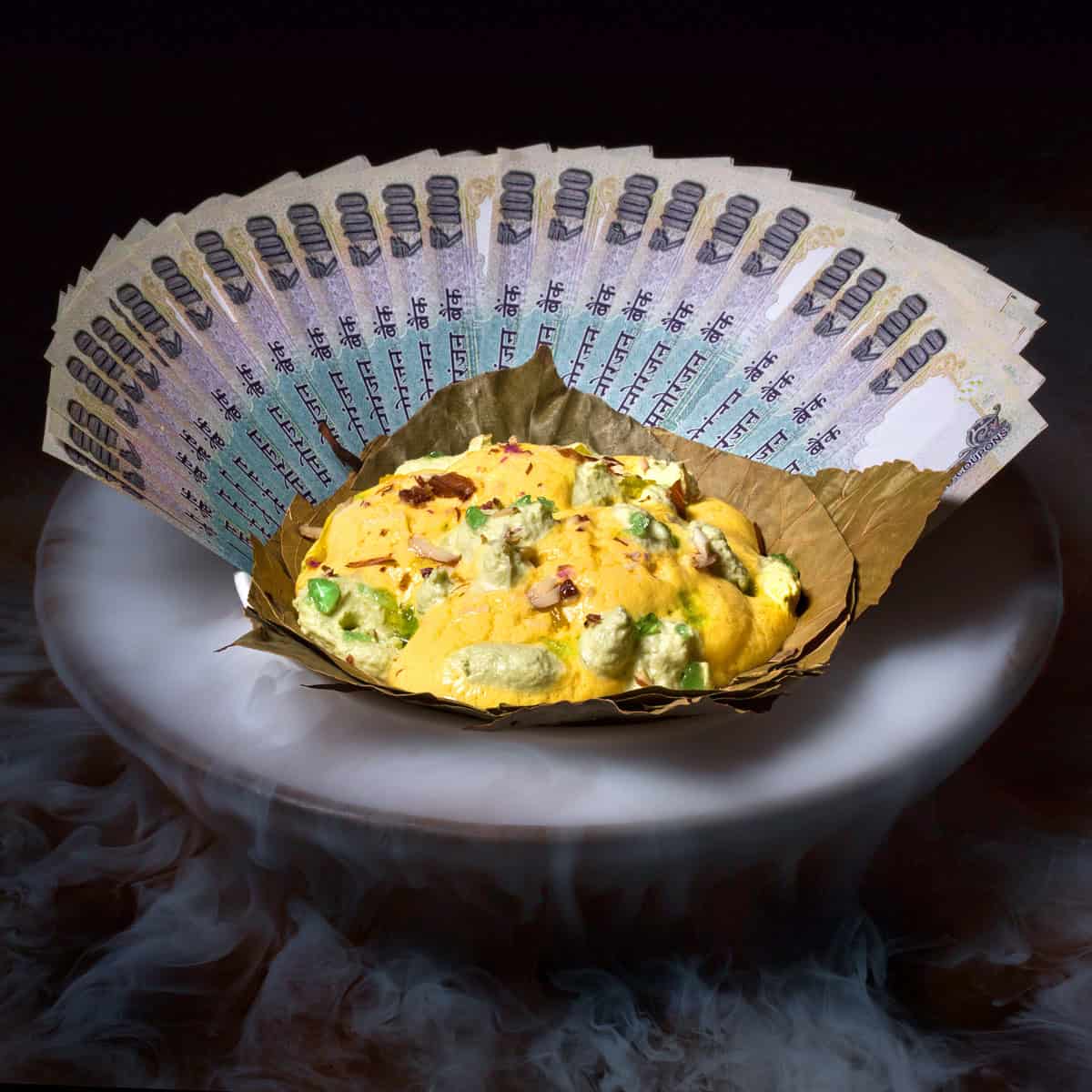
Then come the optional characters, the understudies that can steal the show if used right. Fennel seeds bring a cooling, sweet contrast; ajwain or carom seeds introduce a sharp, herbal note that lingers; and dried mint, with its breezy, fresh sweetness, offers a graceful finish. Ground ginger adds warmth and a whisper of spice, while salt, naturally, binds the whole orchestra together. Some chaat masala recipes also flirt with a pinch of garam masala to amplify complexity, or even a dash of sugar—because in chaat, balance is everything.
These spices aren’t used haphazardly. They are measured, roasted, ground, and layered with intention. The result is a seasoning so addictive, it can turn a boiled potato into a feast or make plain yogurt sing. It’s why chaat, despite being humble in origin, feels anything but basic. The real magic of chaat doesn’t lie in its ingredients alone—it’s in this alchemy of spices, this bold decision to turn flavour up to eleven, unapologetically and joyously.
Lesser-Known Facts: What You Might Not Know
Chaat isn’t a monolith. There are obscure varieties that rarely travel beyond their home cities. Take Daulat ki Chaat, for instance—a winter delicacy of Delhi that’s less chaat and more dessert. Made with milk foam collected before sunrise, flavoured with saffron and sugar, and topped with silver leaf, it’s a sweet cloud you can eat.
Another underrated gem is aloo chana chaat served in Indian train stations—a dry mix of boiled chickpeas, potatoes, raw onions, lemon juice, and chillies. Eaten with a paper cone in hand while the train whistles in, it’s a uniquely Indian nostalgia trip.
In recent years, chefs across India and beyond have taken the chaat formula and created fusion versions. Chaat tacos, chaat pizza, even deconstructed chaat on fine-dining menus—what began on the roadside has now entered culinary couture.
Nutrition-wise, chaat gets a bad rap for being too indulgent. But that depends entirely on how it’s made. With baked bases, home-made yogurt, and plenty of veggies, it can actually be quite wholesome. The digestive spices and fermented chutneys contribute to gut health, while the absence of heavy oils in many varieties makes it lighter than it looks.
Why Chaat Stands the Test of Time
There’s a reason chaat continues to hold India’s collective imagination in thrall. It’s the food of the people—cheap, accessible, endlessly customisable, and built on fresh, everyday ingredients. In a land where every meal tells a story, chaat is the punchline. It’s street food with soul.
Chaat is also democratic. It blurs the lines between rich and poor, urban and rural, local and tourist. You’ll find suited professionals lining up next to college students, children pulling at their mothers’ saris, and tourists taking cautious bites with camera in hand. It’s a unifier. A leveler. A snack that doesn’t ask for permission to be bold.
In India, chaat isn’t merely eaten. It’s discussed, rated, remembered. It is childhoods wrapped in newspapers, dates gone right or wrong, and a constant companion during festival outings or lazy Sunday strolls.
No matter how globalised Indian cuisine becomes, chaat will always remain at its spicy, crunchy, gloriously messy core. It is India on a plate—and one bite is never enough.
Read More: Latest

